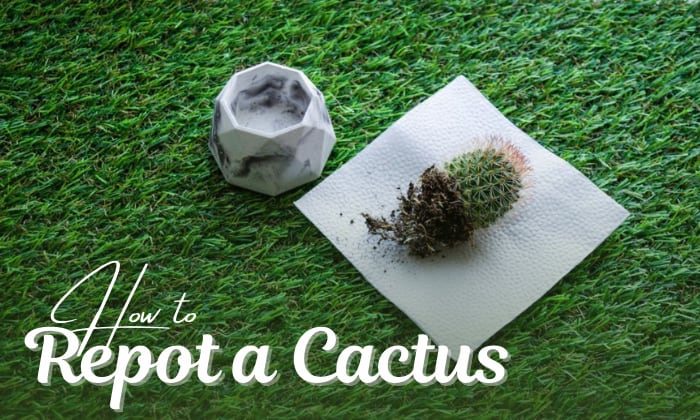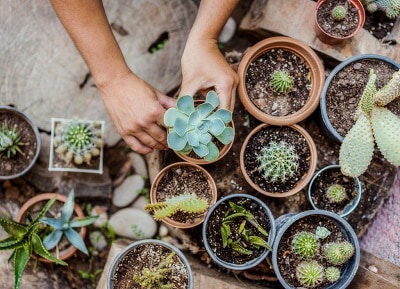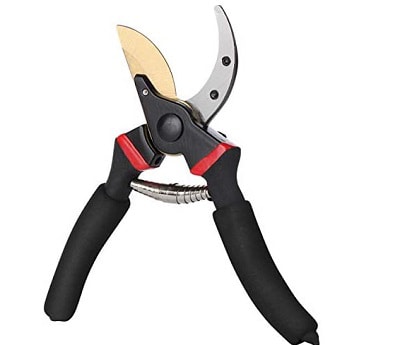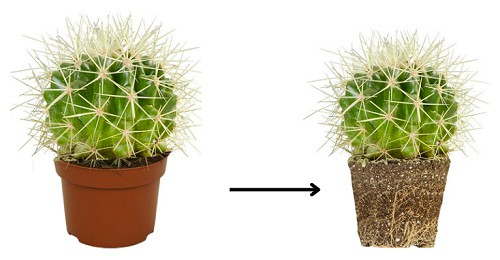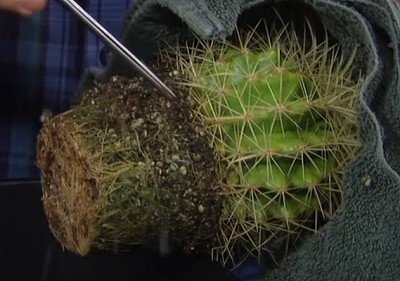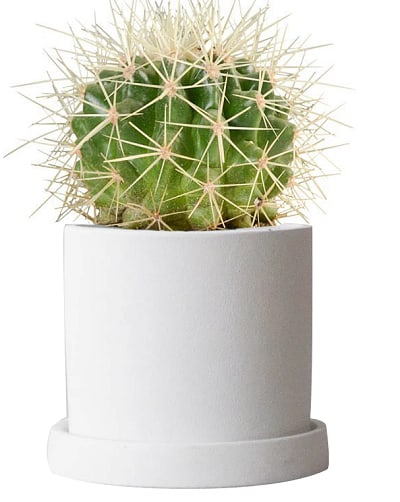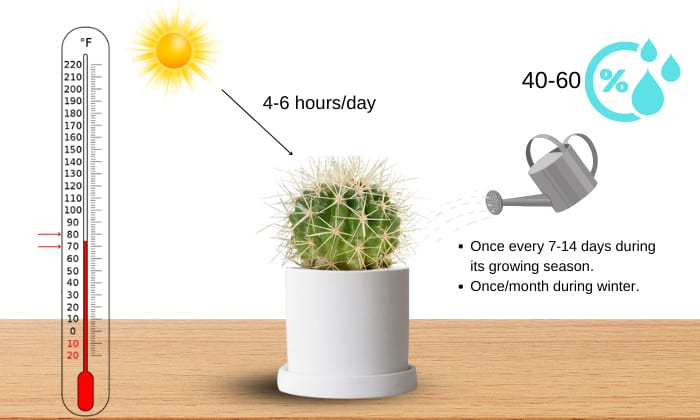Resilient and low-maintenance, cacti are excellent houseplants for busy people. Whether you have a Christmas cactus, Star cactus, or any other variety, it’s easy to decorate your home with them.
The appeal of these succulents is that they purify the air, and provided you transplant them every now and then, cacti will live for ten years, if not longer.
Read below and learn how to repot a cactus.
Table of Contents
Guide to Repot a Cactus
What to prepare
- A new pot
It should be two inches bigger than your current one. Cactus need drainage holes to minimize chances of root rot, so look for those, plus opt for unglazed clay or terracotta containers if possible. These materials will ensure adequate moisture release and aeration.
Plastic won’t make the best pots for cactus, especially if you’re prone to overwatering.
- Thick canvas or leather gloves and a towel
Wearing thick gloves will help you repot a cactus plant without hurting yourself. I recommend wrapping the plant with a towel before touching it, so the spiky cactus won’t puncture your skin.
Alternatively, newspaper sheets or tongs will also work. If you pick the latter, ensure the utensil is made of silicone or foam rather than metal to prevent rough handling.
- Cactus soil
Use a cactus repotting mix instead of a regular container mix. Regular mixes have too much organic matter, which can lead to excess moisture and root rot.
Cactus soil, on the other hand, is lighter and more well-drained. It’s also not fortified with fertilizers, so your plant won’t look spindly and damaged at the roots.
You can buy any commercial cactus soil, but it’s also possible to make your own if you’re in a pinch. Simply combine potting soil, gravel, and perlite or pumice in a 3:3:2 ratio.
- Shears to remove diseased roots
- A butter knife
- 70% Isopropyl alcohol to sanitize your cutting tool
You may also use one part bleach diluted in nine times as much water.
- Pesticide and/or fungicide for sick plants
- Rotary saw or angle grinder (optional)
Steps to replant a cactus
Step 1. Remove the cactus from its container.
- Poke the soil with a butter knife to loosen it. This step will help you transfer cactus to another pot if the soil is too dense and sticks to the plant.
- Next, put your gloves on and squeeze the container with one hand. You can also upend the pot and let gravity do its job. The plant should slide out eventually.
If necessary, ask a friend for help in dislodging a large cactus. Remind them to wear gloves or use a towel while touching the plant.
In case you want to repot a tall cactus that’s impossible to remove, cut the container using a rotary saw or angle grinder. Afterward, gently tap the plant’s roots to remove any old soil left.
Step 2. Save the plant if it’s diseased.
Separate the roots and inspect them for rot, fungi, or pests. If you see any problems, use disinfected scissors to trim off all sick parts, then apply a fungicide or pesticide on the cuts.
Most importantly, let the plant air-dry before replanting a cactus; this step should take four days at most.
Step 3. Transplant a cactus into a pot.
Fill two inches of the new container with your cactus mix, then hold the plant with both hands.
When potting a cactus, follow the same planting depth as before. Put the succulent into the center of the pot and pour more soil into it so that only two inches are empty below the rim.
Do not water cactus after repotting. Wait a week before resuming irrigation.
When to Repot Cacti?
Replant cacti if you see roots poking out of the container or your cactus leaning over in pot. Generally, a repotting frequency of once every two to four years is best, since this is when the soil starts to decline in fertility.
It’s also ideal to transplant cacti in spring, around January to February. The season’s warm weather will signal the plant to start growing, making its adaptation to new environments smoother.
Caring for Your Replanted Cactus
Here are some tips to care for cacti after moving them.
- Give cacti filtered sun during the warm seasons and direct light in winter. Around four to six hours of exposure will do. Note that different cultivars can have different requirements.
A prickly pear cactus, for instance, can handle full sun, while an orchild cactus needs shade or filtered light to grow well.
- Cacti tolerate drought well and prefer a humidity level of 40 to 60 percent. However, misting desert cacti is a terrible idea; only rainforest cactus varieties should receive this treatment. Even then, avoid wetting the foliage and misting more than once per week.
- If you wonder how often to water cactus, the answer is once every seven to fourteen days during its growing season and once a month during winter. Ensure the first inch or two of the soil is dry before irrigating.
- Note that the ideal temperature for cacti is 70 to 80℉. They may tolerate colds as low as 35 degrees, but you should consider 50 degrees the optimal limit. It’s also best to keep these succulents away from strong winds, whether natural or artificial.
- Finally, fertilizing cacti is unnecessary. If you want to give them a growth boost anyway, use cactus fertilizers and not standard ones. Follow the product instructions and avoid feeding the plant during its dormancy.
Cactus Planting Tips
The best way to propagate cacti is by using pups or offsets. Cuttings are the second-best choice, followed by seeds. Here are some quick tips for the more effective methods.
1. Using pups
Choose a healthy cactus with many offshoots. They should be at least one inch tall to increase your chances of success.
Next, gently pull one pup or offshoot from the plant with your gloved hand, and put it into a container containing cactus soil. Make sure to dry the pup prior to planting and ‘sow’ its stem at a depth of ¼ inch only.
Don’t worry if this section comes without roots; it will still grow into a new succulent with proper care.
After you repot cactus pups, give them indirect sunlight and wait five days before watering.
2. Using cuttings
Remove a 10 cm-long cutting from your cactus.
Let this cutting dry and harden for two to three days to prevent rot. You can also apply some horticultural charcoal on the trimmed section to protect it; this measure has the same purpose as sanitizing your cutting tool.
Moreover, dry the cutting vertically so that its roots won’t protrude to the sides. You can put the cactus part in an empty pot before transferring the whole thing to a potting mix. Wait two days after you repot a cactus cutting to water it.
FAQs
How long can cactus go without water?
Cacti in the desert can survive for up to two years without moisture. However, your small potted cactus will need more frequent watering—around once a week to once a month, with winter conditions meriting a higher degree of irrigation.
Do I need to air dry cactus before repotting?
Yes. You should let cactus plants dry to eliminate risks of root rot. If you’ve already gone through the trouble of trimming diseased roots and applying fungicide, there’s no reason not to observe this extra precaution.
Do cactus like to be root bound?
No. Root-bound cacti will become deficient in nutrients. It’s vital to repot these plants before the lack of space hampers their growth or kills them.
Why is my cactus falling over?
Aside from being too big for its pot, a cactus falling over may result from one of the following:
- Overwatering or underwatering
- The container has too much or too little soil.
- The soil is infertile or unsuitable for the plant.
- Root rot or pest damage
- Insufficient lighting
Can I use cactus soil for monstera plants?
Cactus soil is too sandy and low in acidity to accommodate monstera plants. You must mix it with peat moss and compost first (in a 1:1:1 ratio). Otherwise, monstera plants will wilt and deteriorate in this potting medium.
Conclusion
Learning how to repot a cactus shouldn’t take long. The steps are straightforward enough, though they may be time-consuming if your succulent is sick or needs days to dry before transplanting.
Before you leave, feel free to send us a message if you have any questions on this topic. Stay tuned for more discussions on Kosmik kaktus care and other houseplants as well.
Read more tips to repot other plants:

Hi, I am William – Floridayards’ digital content creator. My job is to find answers to all your concerns with thorough research and our team’s expert advice. I will also bring you honest reviews on the best products and equipment for raising your beautiful garden. Please look forward to our work!


